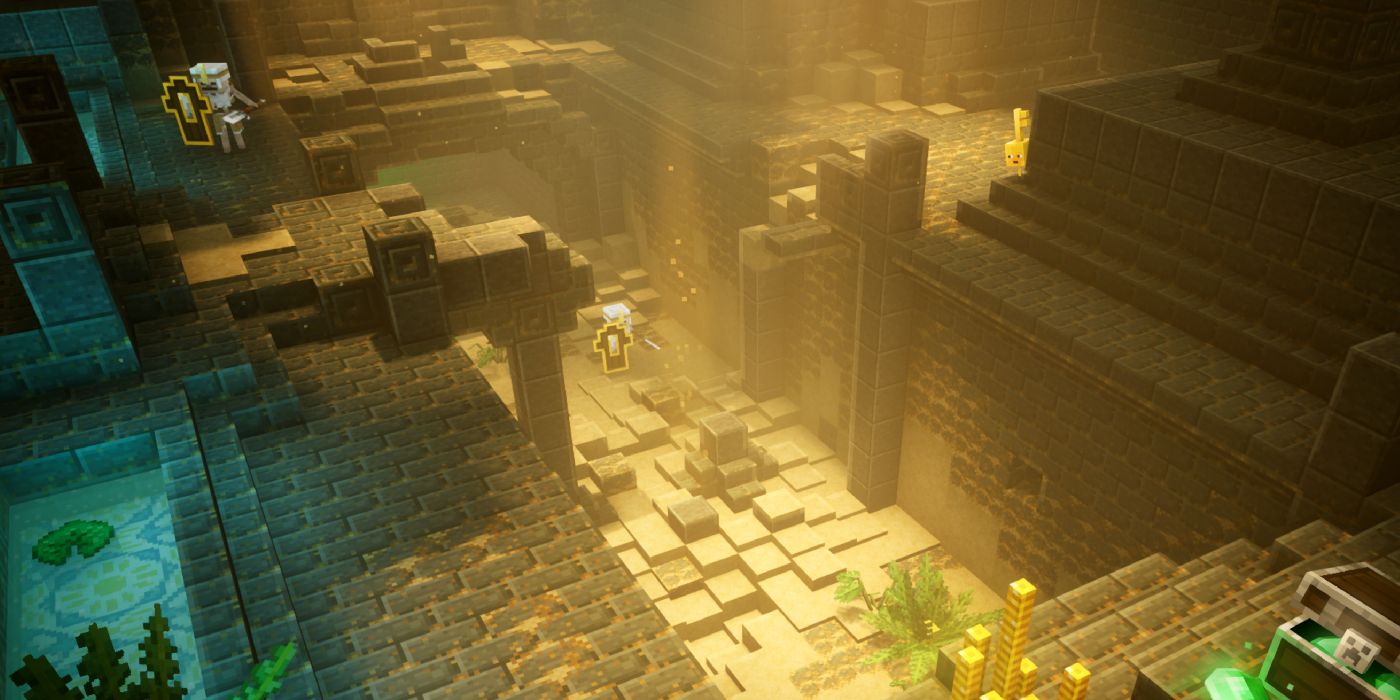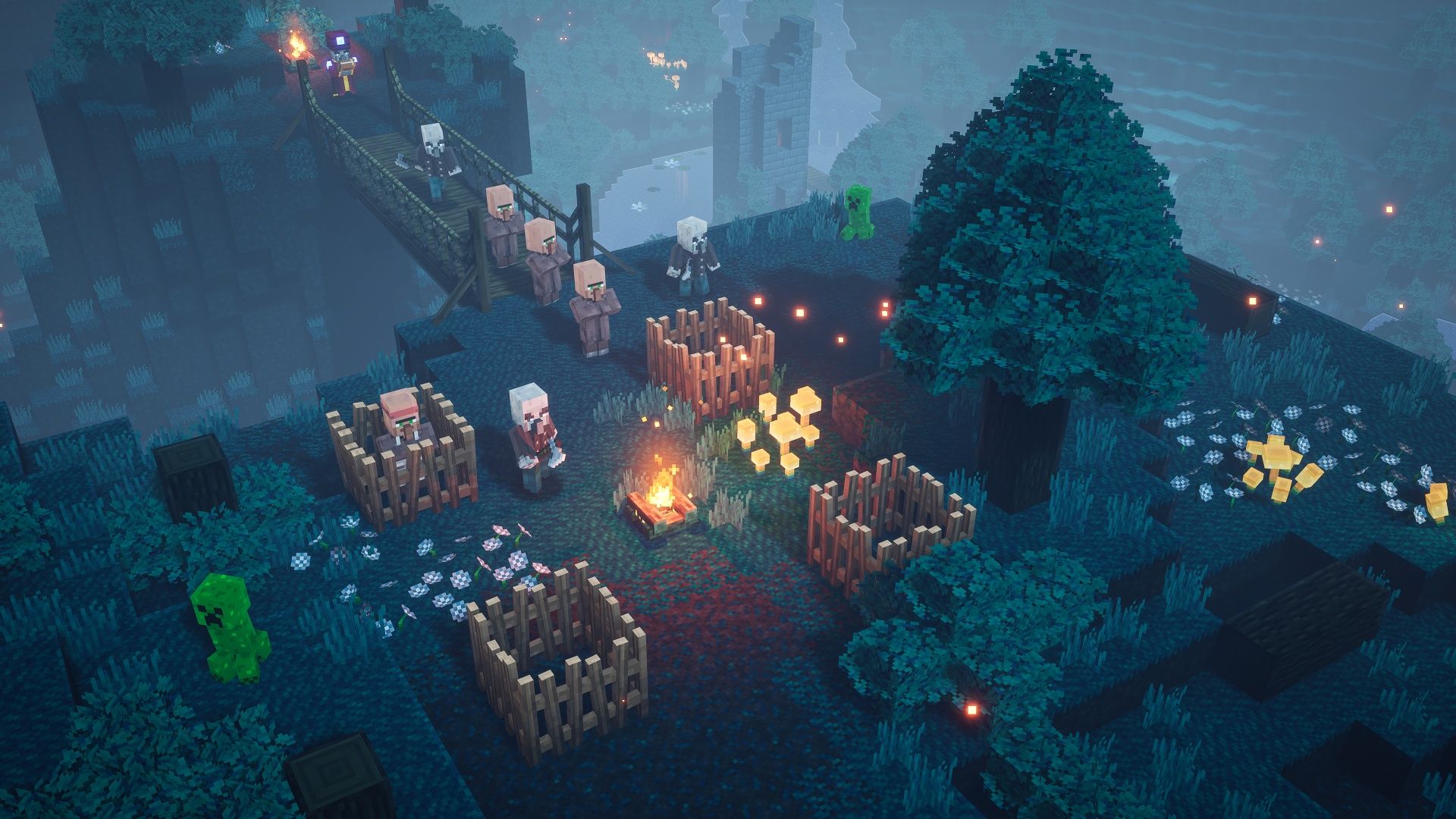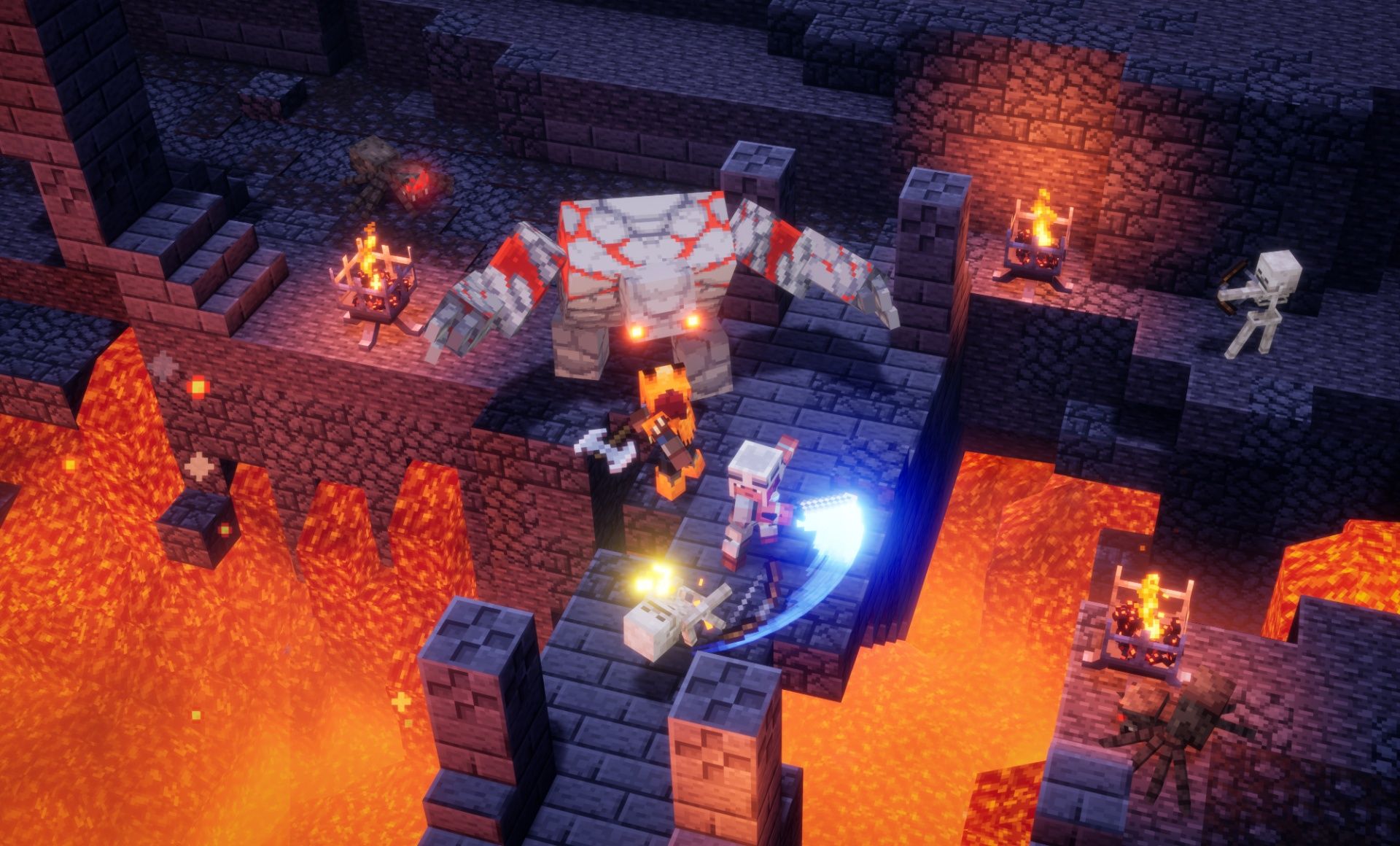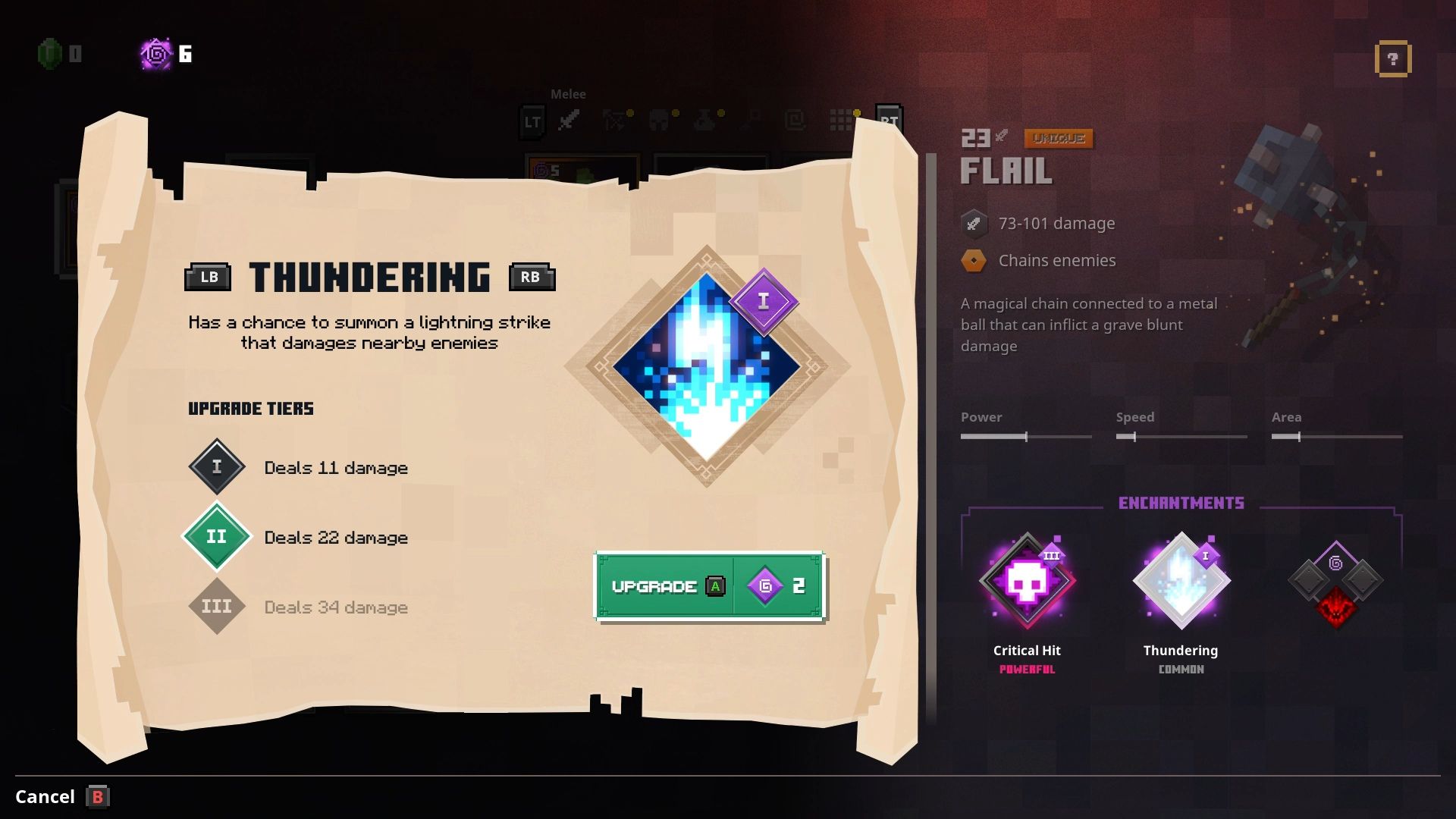There's a lot to appreciate in Mojang's polish. Minecraft Dungeons exists in a market that, just a few years ago, was being flooded with ARPGs that ceaselessly attempted to mimic Diablo and all of its beloved nuances. Now that the trend has petered out, Minecraft Dungeons has attached its name to the asymmetric RPGs that have so clearly inspired it.
Unfortunately, while the Minecraft world is home to millions of beloved memories for its enormous fanbase, this ARPG spinoff doesn't stoke the flames of nuance or nostalgia, instead piggybacking off of the art style that has been so deeply influential in the past decade. There were a lot of opportunities for Minecraft Dungeons to remind its players of their love of Minecraft, but beyond its skin being very much like Minecraft — sharing similar settings, enemies, and obstacles — it winds up only being Minecraft in name.
When one thinks of Minecraft, they undoubtedly first recall the art style; blocky, jarring, and even abrasive to some. The low-detail cubic design is perfect for terrain deformation and building. The lack of character details allows players to customize. The world is generated and infinite. But perhaps equally thought of is Minecraft's most appealing system: its design elements. While the game was and still is, at its core, survival. It became so much more once people began to play around with the building tools it provided. Since then, thousands of modded servers have sprung up that have provided millions with nightly entertainment. But that number cascades into the billions once the YouTube viewership comes into play, for Minecraft's pleasure isn't just in the playing (the building), but also the watching. With its release came a wave of fans that have, for all intents and purposes, not even played the game. The truly exceptional creativity allowed in the original title didn't require gameplay, but appreciation, to enjoy.
Enter Minecraft Dungeons: a loot-infested dungeon crawler with none of the crafting or building or creativity of its inspired predecessor. Instead, Dungeons uses the art style associated with Minecraft to create a polished, simple adventure more akin to Minecraft: Story Mode released by Telltale Games in 2015 than its original source of inspiration. While it retains the most intrinsic quality (the art), it loses the most mechanically beloved element. There is build customization, but it doesn't match its ARPG competitors, let alone Minecraft's original creativity. The art style, for once, clashes with purpose. Originally, the blocky nature of the game was implemented to create simpler, more malleable assets for the user to deform and create with. The simplicity was key for the most important mechanic to work. By removing that mechanic entirely, one loses agency in the blocky style that has been mimicked by dozens of games since.
Regardless, the player is sent on a not-so-sprawling adventure through nine levels, each inhabiting a titular zone from the original game. You prance through creepy woods, skulk through infested crypts, and saunter in the pumpkin pastures. Each setting is unique enough, albeit clearly made with similar assets. Certain areas can be quite charming in their beauty, while others (the crypt) are mostly just a monotonous, dark grey and brown. With the art being the only recognizable element of Minecraft the multitude of overlapping weapons (swords, pickaxes, axes, etc.) are lifted from the base game but aren't exactly unique in the fantasy RPG genre. It mostly just feels like a Minecraft skin that has been draped over a relatively polished ARPG.
When it comes to the game itself, the adventure hinges on an evil Illager, the Arch-Illager, that has gained an unbelievable amount of power. He began using said power to destroy certain areas of this world and you, the hero, must save all the quirky characters that have been trapped by him. From this, the gameplay loop begins to take hold. You pick one of the nine levels in a nonlinear fashion and proceed to hack n' slash your way through them. Enemies tend to drop loot, emeralds (the currency), and experience which levels up your character, giving you points to spend on upgrading your weapons and armor. Each weapon and armor is imbued with an enchantment that you can upgrade.
This is easily the game's most in-depth system, even if it is hardly complicated. One can craft their build by looting specific items with synergizing enchantments. On top of that, the player receives three one-use items that alter their gameplay. From fishing rods that reel enemies in, to mutton-chops that call a friendly wolf to serve at the player's side; the items, while unique, are unfortunately not too varied. Just an hour into the playthrough of an already short, albeit replayable game, and most of the base items will have already been seen. For a game that, once again, flaunts a rather simple art style, assets shouldn't be overly difficult to craft. This means that the number of weapons and armor should be a top priority, especially for an ARPG where the player is constantly getting upgrades and swapping out their items on the fly.
Items may differ statistically (there is a base power level which indicates strength), switching from a generic sword with fourteen power to a generic sword with sixteen power isn't compelling, especially since enchantments also seem to lack a good amount of diversity. One of the main needs for Minecraft Dungeons is just "more". There need to be more levels, more items, more customization for it to be worth investing time into. The campaign will take a few hours to complete, once done, a harder difficulty is unlocked to essentially complete it again with better loot. Rarer items do have more unique affixes to them (think of a bow that shoots two enemies instead of one) but the simplicity should've been a path to create more content, not settle for a minimum amount, which unfortunately must be addressed: the game promises future updates, so much so that future levels are shown with the logo "coming soon" emblazoned beside them. This promise of content may seem heartening to worried players. However, one must think of the "games as a service" trend that has perpetually forced games into early releases only to drip-feed content into them or cancel them altogether if the sales didn't live up to expectation. If you do not purchase the Hero Edition of the game, you'll have to pay for DLC to complete the experience. Similarly, cross-play between the platforms is also not ready for launch so co-op play is online and local, but platform-specific for the time being.
There should be faith in Mojang, but one should definitely consider just how much content they are buying with twenty dollars (or thirty with the Hero Edition). There are many, many indie games that offer far more content than the few hours Dungeons currently provides (barring repetition), and while the gameplay itself is undoubtedly polished, one can't help but wonder if the price tag is including the levels they have yet to add. In that case, perhaps waiting for a few months may be the best option. The simplified systems found in Dungeons would perhaps best be tuned for mobile gaming, although Mojang has been explicit in not working on a mobile port as of yet. As an entry-level ARPG this could work, and for many rabid Minecraft fans it could be fun, and, in some ways, it definitely is. Unfortunately, the lack of personality sets this cute dungeon crawler back.
Minecraft Dungeons is available for the Nintendo Switch, PlayStation 4, Windows, and Xbox One. Screen Rant played on Windows for this review.




